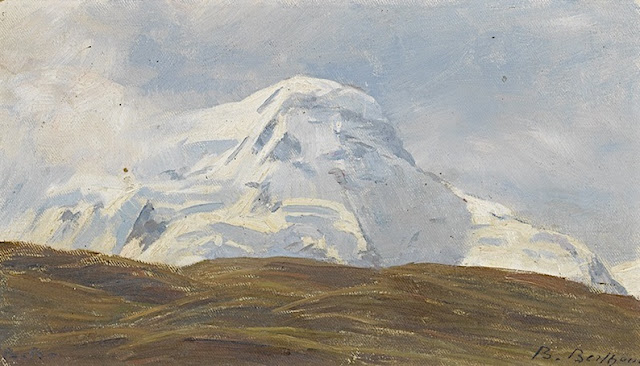EDWARD LEAR (1812-1888)
Mount Athos (2,033 m - 6,670 ft )
Greece
1. In view of Mount Athos in a distance, 1848, oil
2. In The Monastery of Stavroniketes, Mount Athos, 1861, oil
3. In A distant view of Mount Athos, 1856, watercolor,
4. In The Monastery of Xenophontos, Mount Athos, 1856, watercolor
4. In The Monastery of Xenophontos, Mount Athos, 1856, watercolor
The mountain
Mount Athos (2,033 m - 6,670 ft ) is a mountain and a peninsula in northeastern Greece and an important centre of Eastern Orthodox monasticism. It is governed as an autonomous polity within the Greek Republic under the official name Autonomous Monastic State of the Holy Mountain (Greek: Αὐτόνομη Μοναστικὴ Πολιτεία Ἁγίου Ὄρους). Mount Athos is home to 20 monasteries under the direct jurisdiction of the Ecumenical Patriarch of Constantinople.)Mount Athos is commonly referred to in Greek as the "Holy Mountain" ( Ἅγιον Ὄρος) and the entity as the "Athonite State" (Αθωνική Πολιτεία). Other languages of orthodox tradition also use names translating to "Holy Mountain" (e.g. Bulgarian and Serbian, Russian, Georgian). In the classical era, while the mountain was called Athos, the peninsula was known as Akté (Ἀκτή).
Mount Athos has been inhabited since ancient times and is known for its nearly 1,800-year continuous Christian presence and its long historical monastic traditions, which date back to at least 800 A.D. and the Byzantine era. Today, over 2,000 monks from Greece and many other countries, including Eastern Orthodox countries such as Romania, Moldova, Georgia, Bulgaria, Serbia and Russia, live an ascetic life in Athos, isolated from the rest of the world. The Athonite monasteries feature a rich collection of well-preserved artifacts, rare books, ancient documents, and artworks of immense historical value, and Mount Athos has been listed as a World Heritage Site since 1988.
Although Mount Athos is technically part of the European Union like the rest of Greece, the status of the Monastic State of the Holy Mountain, and the jurisdiction of the Athonite institutions, were expressly described and ratified upon admission of Greece to the European Community. The free movement of people and goods in its territory is prohibited, unless formal permission is granted by the Monastic State's authorities, and only males are allowed to enter.
The painter
Edward Lear was an English artist, illustrator, musician, author and poet, and is known now mostly for his literary nonsense in poetry and prose and especially his limericks, a form he popularised. His principal areas of work as an artist were threefold: as a draughtsman employed to illustrate birds and animals; making coloured drawings during his journeys, which he reworked later, sometimes as plates for his travel books; as a illustrator of Alfred Tennyson's poems. As an author, he is known principally for his popular nonsense collections of poems, songs, short stories, botanical drawings, recipes, and alphabets. He also composed and published twelve musical settings of Tennyson's poetry.
Lear was already drawing "for bread and cheese" by the time he was aged 16. (...)
Complete biography and others mountain paintings by Edward Lear already published in this blog
Edward Lear was an English artist, illustrator, musician, author and poet, and is known now mostly for his literary nonsense in poetry and prose and especially his limericks, a form he popularised. His principal areas of work as an artist were threefold: as a draughtsman employed to illustrate birds and animals; making coloured drawings during his journeys, which he reworked later, sometimes as plates for his travel books; as a illustrator of Alfred Tennyson's poems. As an author, he is known principally for his popular nonsense collections of poems, songs, short stories, botanical drawings, recipes, and alphabets. He also composed and published twelve musical settings of Tennyson's poetry.
Lear was already drawing "for bread and cheese" by the time he was aged 16. (...)
Complete biography and others mountain paintings by Edward Lear already published in this blog


























